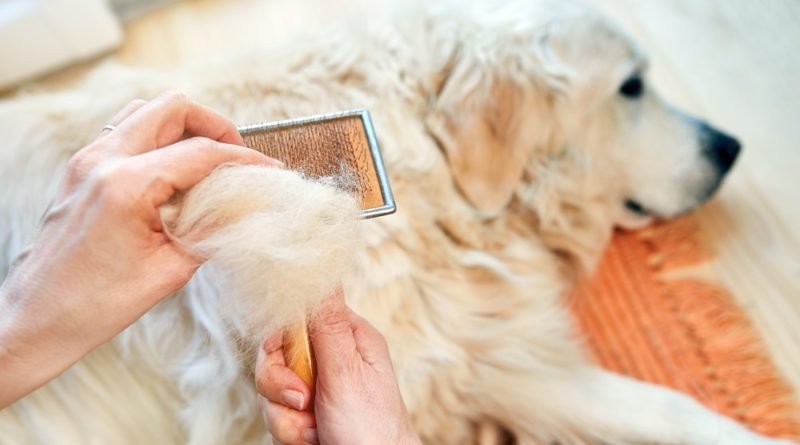Last modified on August 25th, 2021 at 5:41 am
Reasons for Hair Loss in Dogs
Hair loss in our dogs can be worrying. Is it just hair loss, or is it part of something bigger? Take a look at our guide to help determine whether or not you need to call the vet.
Allergies
If your dog is showing symptoms like itchy skin, rashes, ear infections, saliva staining, weepy eyes, or hot spots on their skin, your dog may have an allergy.
Flea bites are the cause of most allergies in dogs. Dogs licking or biting the irritated area frequently will cause hair loss. Some dogs are prone to allergies more than others, so consult your vet on how to treat them. There are products for dealing with fleas online and in pet stores, but you will need to speak to a vet if you want a prescription-level product since products without a prescription are often less effective.
Like the rest of us, dogs can also have food allergies. Wind, weight loss, and diarrhea can indicate a food allergy in particular. Consider changing their food or giving them an antihistamine.
Environmental allergies such as pollen, trees, dust mites, or grass are likely to give your dog itchy skin at certain times of the year. Avoid walks where the pollen count is likely to be high and stick to the pavement to avoid this.
You can buy skin supplements to improve the condition of your pet’s skin, but there is also the option of immunotherapy. Speak to your vet about whether immunotherapy is likely to work on your dog.
Alopecia
Alopecia is the most likely cause of your dog losing fur. It can be inherited from their mother or father or be due to ongoing contact like around the neck if your dog wears a collar or on the elbows from lying on hard surfaces. The skin on these areas can gain callouses, but it shouldn’t worry a pet owner.
It is common but isn’t cured with medication unless there is another underlying reason for it.
Alopecia can also be seasonal. Developing in the autumn, it’s possible their fur may grow back in six to 12 months and may reoccur. It’s common in Boxers, Bulldogs, Dobermans, and Staffordshire Bull Terriers.
Post-clipping alopecia can occur in heavy-coated breeds over areas that have been recently given a haircut for perhaps surgery reasons or to keep cool in warmer climates.
If your dog has recently gotten a rabies jab, the skin around the area might see some loss in fur.
There is also such a thing as dog-pattern-baldness, which sees hair loss around the ears, the legs, and belly. It begins at six months old and progresses to almost complete hair loss over the continuing 12 months. It is common in Dachshunds, Boxers, Boston Terriers, Chihuahuas, Whippets, Manchester Terriers, Greyhounds, and Italian Greyhounds.
Over-grooming
Dogs can over-groom due to stress, pain, or irritated skin. If your dog’s fur becomes matted, the skin underneath might be irritated by the moisture and bacteria trapped on the skin’s surface. It can cause fur loss, saliva staining, and red skin. This is where the dreaded cone comes in. You can also train them not to groom so much by distracting them when you see it happening too much.
Ringworm
Ringworm is a fungal skin infection and actually has nothing to do with worms. It causes a “ring” of hair loss and crusty skin in patches and is very contagious. It can, in fact, spread to humans through direct contact and on surfaces.
Mild ringworm cases can recover without treatment, but due to its contagiousness, it’s best to have it treated as soon as possible. There are medicated shampoos available to help treat ringworm and anti-fungal oral medicines. Clip your dog’s coat to help avoid spreading the fungus and to help the shampoo work.
Hormone diseases
Hormonal problems such as hypothyroidism and Cushing’s disease are common causes of hair loss in dogs and can be treated with medication.
Hyperthyroidism can be diagnosed if your dog has an unexpected weight gain or difficulty losing weight, hair loss on the tail especially, low energy, dandruff, skin infections, shivering, and thick skin around the face giving your dog a sad expression. The thyroid glands become underactive and don’t produce enough hormones. These are often caused by the immune system accidentally attacking the thyroid glands. It is likely to affect Dobermans, Golden Retrievers, Boxers, Great Danes, and Old English Sheep Dogs. Treatment could see your dog feeling better and back to normal within six months. Treatment may cause more fur loss, but it will grow back.
Cushing’s disease is less simple. Look out for excessive drinking and peeing, a swollen stomach, excessive hunger, thin skin prone to blackheads, low energy, and muscle loss. It is caused by high levels of steroids in the body and may indicate a small brain tumor or adrenal gland tumor. Your vet may consider medicinal treatment or surgery, and your dog may be on medication for the rest of its life.




